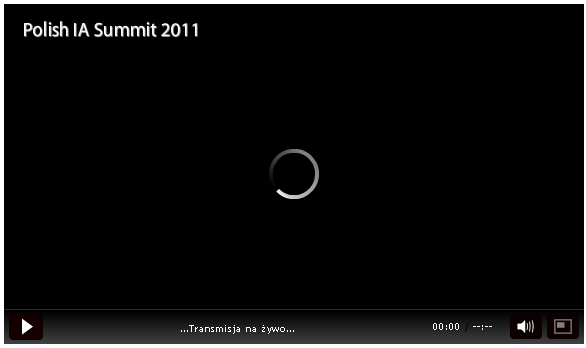Dziś rozpoczyna się konferencja Polish IA Summit 2011. Poniżej streaming na żywo z konferencji.. Transmisja się zakończyła, poniżej znajduje się placeholder.

Archives for April 2011
Transmisja z konferencji Polish IA Summit 2011
IA Summit – The fall and rise of user experience
Gorąco zachęcam do zapoznania się z transkrypcją z przemówienia The fall and rise of user experience wygłoszonego przez Cennydd Bowlesa na zakończenie dorocznego amerykańskiego spotkania architektów informacji – IA Summit 2011. Fragment:
We shouldn’t feel threatened or sentimental about labels. The disciplines within UX design are here to stay, and have gained sufficient maturity to become a competency within all forms of design, not just the domain of one group of practitioners. Our skills will always matter, and we will always design good experiences. So I don’t care what you call yourself. The work is what matters. The label is just metadata (…)
Rather than explain our expertise through process and terminology, we should point at our output. If we are indeed worthy of the praise we’ve been receiving, our outputs had better be demonstrably better than others’. Otherwise, perhaps our detractors are right.
Pełna transkrypcja dostępna jest na stronie prelegenta – The fall and rise of user experience : Cennydd Bowles on user experience.
Tylko u nas – Wywiad z Peterem Boersma
 Jeśli odwiedzacie UXLabsy inaczej niż przez czytniki RSS, to zauważyliście, że wiecie że jesteśmy patronem najbliższej konferencji Polish IA Summit. W związku z tym, postanowiłem skorzystać z okazji i przepytać prelegenta prezentacji zamykającej konferencję i doświadczonego praktyka UX, pracownika Adaptive Path – Petera Boersma (na zdjęciu obok). Zapraszam do lektury!
Jeśli odwiedzacie UXLabsy inaczej niż przez czytniki RSS, to zauważyliście, że wiecie że jesteśmy patronem najbliższej konferencji Polish IA Summit. W związku z tym, postanowiłem skorzystać z okazji i przepytać prelegenta prezentacji zamykającej konferencję i doświadczonego praktyka UX, pracownika Adaptive Path – Petera Boersma (na zdjęciu obok). Zapraszam do lektury!
Tomasz Skórski: Over six years ago, you have proposed T – model, which includes interaction design, usability, information design, visual design, accessibility, copywriting, business modeling, marketing and computer science. Do you feel this model is still valid? If not, what would you change?
Peter Boersma: Yes, I believe the model is still valid. A year after I proposed the model I had a chance to explain it to the Advisors and Board of Directors of the Information Architecture Institute and in the discussion that followed it seemed that the model is good for discussing the field as well as relationships with other fields.
In my keynote for the Polish IA Summit, I plan to spend some time on this model too, and show why Information Architects should look around at other fields and how it relates to their work.
TS: In your presentations, you are spreading the idea of ‘design review’ as an important part in development process According to you this should take about 10 per cent of project time. I know that from some of Polish clients’ perspective, it seems to be – unfortunately – unrealistic idea. How do you convince your clients to spent this amount of time on it?
There are (at least) two answers to this:
- internal reviews are just part of the work; you do not *have* to tell your clients about this, because they are not present and should only see the outcome of the reviews: deliverables from your team that match your quality standards, that work towards the project goals and that all talk about the same solutions.
- reviews with the client are the best way to see if your work matches their expectations, and to gather input for decisions that help you put more detail in the next set of deliverables. These meetings should take place at critical points in the project, e.g. when you are done with the analysis of your user research, when you have developed one or more high level concepts for the system, when you need input on detailed design decision, etc. Oh, and preferably, you have at least one evaluative review once the project has ended.
TS: I know that you are speaker on some IA Summits. What do you think about the progress that information architecture has made as academic science during last few years?
PB: I am afraid that I have very little insight in this.This may be a sign that little progress has been made, or that I am out of touch with the academic
world. But I do know of some efforts, specifically the work that Karl Fast is doing at Kent State university and the establishment of the Journal of IA by people like Andrea Resmini and Dorte Madsen. I know that IA is being taught in many places (check the IA Institute’s list) but that there is no central hub.
TS: What do you think about last years hot subjects: service design, content management and customer experience. Do you find them as a part of user experience?
PB: To start with the last one: Customer Experience is for me a flavor of User Experience, with a added dose of sales & marketing. The good thing about CX is that it looks at longer term effects too, and doesn’t simply go for the kill.
Content Management has always had a bad name, mostly because CMS manufacturers used to create bad out-of-the-box experiences: after buying a CMS, you had to spend a lot more money on consulting services to tweak the standard solution into something useful. And then they had many technological problems (like limited flexibility in templates, lack of personalization options, no smart navigation, etc.) that hindered creating a good user experience.
Service Design will be around for a while and is, in my view, a lot wider than user experience. It includes big chunks of organizational design and, although launching a new UX for a system has some influence on how an organization should function, this is a core aspect of Service Design. Still, because UX practitioners should have a wider view than just IA, Interaction Design, or Communication, they are in a good position to transfer to the Service Design field, assuming they also learn how organizations work, and how interactive systems change that.
TS: Do you find organizations like UPA, ACM SIG CHI or IAI useful? How do you see their role?
PB: They are enormously useful! They help practitioners connect, either through publications, discussion fora, events, or mentoring, and have the opportunity to link academia, practice, press, and politics in ways that help advance the field. I am personally grateful to ACM SIGCHI for organizing their CHI conferences and publishing the proceedings, and I remember how the IAI and Kent State university together sponsored an IA section in Fortune magazine. I have also been a mentor and mentored, and cannot state the importance of such a relationship for individual practitioners.
TS: In last year Adaptive Path has opened its first office in Europe. Have you found (as a company) differences between European and American market?
PB: It may be a little early to tell. We have found some differences in doing business (European companies seem to be slower with signing contracts and setting up approval for payments) and terminology (a German bank was sure they needed a training in IA, but when we showed them the material for an Interaction Design training they realized that’s what they needed), but overall the need for User Experience research, strategy, and design seems to be universal.
But as a company, we are ready to share and analyze any differences we suspect to have found: one of the reasons for Adaptive Path to set up a European office is to help clients that want to cross the Atlantic Ocean (in whichever direction) and make sure that their designs match the audience on “the other side”.
TS: Which of the usability and user experience books would recommend to our readers?
PB: Because the field of User Experience is so wide, and there is even more to learn from adjacent fields, the list is endless :-) I can tell you which books I (re)read recently and enjoyed. They are, in alphabetical order:
- A Theory of Fun for Game Design, by Raph Koster
- Cartographies of Time – A History of the Timeline, by Daniel Rosenberg and Anthony Grafton
- Designing for People, by Henry Dreyfuss
- Everyware, by Adam Greenfield
- Sketching User Experiences, by Bill Buxton
- Subject to Change, by Peter Merholz, Brandon Schauer, David Verba and Todd Wilkens
- The Design of Design, by Frederick P. Brooks, jr.
- The Elements of User Experience (2nd edition!), by Jesse James Garrett
- This is Service Design Thinking, by Jakob Schneider and Marc Stickdorn
- Undercover User Experience, by Cennydd Bowles and James Box
Prezentacja – Mobile Content: The Return of Shovelware?





Recent Comments